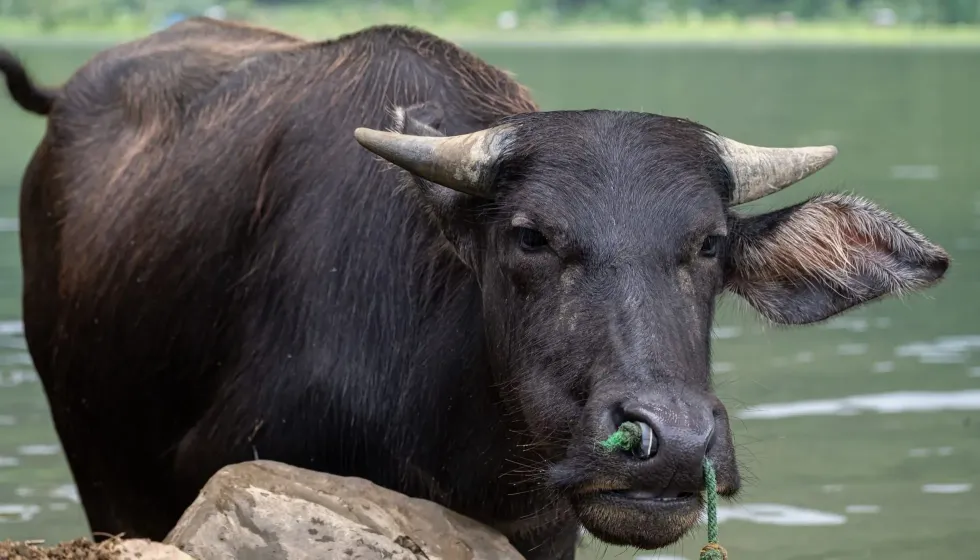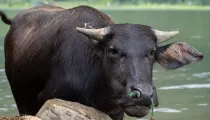Buffalos are some of the most common animals seen in the wild and in captivity.
They belong to the subfamily Bovinae and have hoofs on their legs and horns on their heads. The tamaraw (Bubalus mindorensis) is also known as the Mindoro dwarf buffalo.
It is a Critically Endangered species of buffalo according to the International Union for Conservation of Nature (IUCN) Red List of Threatened Species and it is endemic to Mounts Iglit-Baco National Park and Aruyan in the island of Mindoro.
A massive and sudden decrease in the population of the tamaraw has been caused by human activities like logging and hunting that are detrimental to the living environment and natural resources within the tamaraw habitat range.
Tamaraw conservation efforts have been taken up by the Philippine Department of Environment and Natural Resource since 1936, when even wounding a tamaraw was made a punishable offense.
This tamaraw conservation program by the Philippine government is the main thing keeping the species from becoming completely extinct.
There have not been any large increases in the tamaraw population in the last five decades or so due to the fact that the species is endemic to the Philippines and finds it hard to adapt to other habitats.
The Mindoro dwarf buffalo is short, small, and stocky.
They have a V-shaped pair of horns on their head and show little to no sexual dimorphism, meaning males and females of the species have mostly the same features apart from their reproductive organs.
Tamaraw symbolism is rife in Philippine culture: the animal was present on a version of the one peso coin, Toyota has released two car models with its name, and it is the mascot of several universities in the island nation.
If you go on to enjoy this article on the Critically Endangered tamaraw, make sure to check out our facts pages on the water buffalo and the cape buffalo.
Tamaraw Interesting Facts
What type of animal is a tamaraw?
The tamaraw (Bubalus mindorensis) is a type of buffalo.
What class of animal does a tamaraw belong to?
The Mindoro dwarf buffalo (Bubalus mindorensis) is classified as a member of the Mammalia class, meaning they are viviparous (produce live young) and nurture them with mammary glands present in the female.
How many tamaraws are there in the world?
Due to widespread habitat loss suffered by the species, the latest estimates say that there are only about 500 individuals in the Mounts Iglit-Baco National Park and 30-200 in the wild.
Where does a tamaraw live?
The tamaraw is endemic to the Philippine island Mindoro, where it enjoys protected status in the Mounts Iglit-Baco National Park alongside other interesting animals like the fruit bat. It is also found in Aruyan, Mindoro. Despite concerted tamaraw conservation efforts, tamaraws continue to be Critically Endangered on the IUCN Red List of Threatened Species.
What is a tamaraw's habitat?
This species lives in moist forests and grasslands with a well-established source of water and mud. Large-scale habitat loss has been observed in the past century, largely due to increased human activities in Mindoro.
Who does tamaraw live with?
Unlike other buffalos, the tamaraw is a largely solitary animal. Males and females can be seen in pairs when breeding, but the interaction is short-lived.
How long does a tamaraw live?
The average lifespan of a tamaraw is around 20-25 years.
How do they reproduce?
The Mindoro dwarf buffalo reproduces sexually. After mating, the female raises the baby alone. After a gestation period of around 300 days, a reddish-brown baby is born without horns. The horns grow slightly thicker and larger in males than in females over the two to four years that the baby spends with its mother.
What is their conservation status?
Tamaraws are Critically Endangered according to the International Union for Conservation of Nature (IUCN) Red List of Threatened Species.
Tamaraw Fun Facts
What does a tamaraw look like?
The tamaraw is a short and stocky species of buffalo. It has a grayish-black coat with darker lines running along the spine and lighter lines around the neck and eyes. They are born far lighter, in a red-brown color, and without horns.
Horns grow in juvenile tamaraws over around four years. Males and females look largely the same, with the slightly thicker male horns almost impossible to distinguish without measurement.
Unlike the carabao and the water buffalo, this animal's horns are V-shaped instead of circular. They have become nocturnal in the wild due to human activities resulting in habitat loss. In captivity, they are most active during the afternoon.
How cute are they?
The tamaraw is a tough and rugged creature, and it is perhaps the juvenile tamaraws alone that appear cutest to the human eye.
How do they communicate?
Tamaraws are known to be able to show aggression by lowering and shaking their horns. Males have been seen chasing away others from their source of food or water, an increasingly common sight due to the current population of the species. Other tamaraw characteristics used to convey information to others are obscure.
How big is a tamaraw?
A tamaraw can grow to around 86.6 in (220 cm) in length, meaning it is half the size of the average bison and nearly twice the size of a Saiga antelope.
How fast can a tamaraw run?
While the sprint speed of this particular species has not been studied, it is known that other buffalos can hit speeds of around 35 mph (56.3 kph). Imagine how terrifying seeing this powerful beast hurtling toward you at that speed would be!
How much does a tamaraw weigh?
An adult tamaraw weighs a whopping 440.9-661.4 lb (200-300 kg). Can you believe this is a relatively low weight for a buffalo?
What are their male and female names of the species?
A male tamaraw is called a bull, and a female is called a cow.
What would you call a baby tamaraw?
A baby tamaraw is called a calf.
What do they eat?
Tamaraws eat various different varieties of grass. During the rainy season, they enjoy feeding on bamboo shoots. They are known to frequent sites that have been recently burnt by slash-and-burn farmers to feed on young grass growing there. Breastfeeding mothers eat far more nutritious types of grass and are willing to pass on dying or stale grass.
Are they poisonous?
They are not capable of producing any harmful toxins. However, this is no reason to attempt to provoke a tamaraw since they can be extremely aggressive around humans.
Would they make a good pet?
Considering the fact that the tamaraw is one of the most endangered species in the world, it would be ill-advised to keep one as a pet. Besides, they require a large amount of food and an open area to move around in on a daily basis, which would make them nearly impossible to keep as a pet.
Did you know...
The tamaraw is believed to have played a vital role in the ecosystem of the Philippines, back when it was found on every island. They are important fruit seeders and pollinators to this day, although their actual impact on the ecosystem is virtually negligible now due to their tiny population.
Why are tamaraws endangered?
The tamaraw population is endangered due to human activity. In the 1900s there was a large spike in the hunting of the tamaraw, which was seen as encroaching on human territory. Additionally, climate change and pollution also contributed to today's small tamaraw population. It is not extinct, although it is on the verge of extinction.
What is the difference between the tamaraw and the carabao?
When comparing tamaraw vs. carabao fact, there are several different physical features and behaviors that separate the two animals. The tamaraw is slightly smaller and shorter and has straight, V-shaped horns.
It is also slightly hairier and has dark and light markings across various parts of its body. Finally, the carabao is a sociable animal, moving in herds, while tamaraws can spend most of their adult lives alone.
Here at Kidadl, we have carefully created lots of interesting family-friendly animal facts for everyone to discover! Learn more about some other mammals from our spiral-horned antelope facts and Sri Lankan elephant facts pages.
You can even occupy yourself at home by drawing one on our free printable Tamaraw coloring pages.









